
Just because a place is off the beaten path doesn’t mean that a path should not be beaten to it.
We’ve discovered this to be true on several occasions — sometimes by accident — other times by design, as with our visit to Valladolid.
We had heard that this impressively preserved colonial settlement hidden away in the heart of Mexico’s Yucatan Peninsula was a gem, so we made tracks to find out for ourselves.

It only took walking the couple of blocks from the bus station to our hotel on the main square for us to fall in love with the place, and we knew the reports were right.
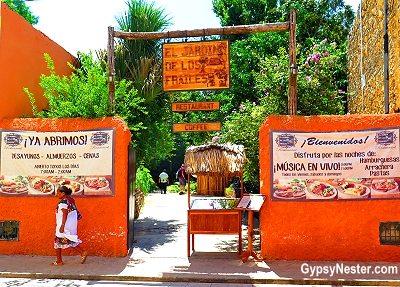
It certainly looked as though very little had changed since the Spaniards built the town nearly five hundred years ago, but the city’s history actually predates their arrival.
The Mayan town of Zaci held claim first, until the Spanish pushed the villagers out and used the stones from their city to build a new settlement named after the old capital of Spain.


The Mayans were not that easily deterred.
They attempted to take back the city two years later, but were defeated. Over the next three centuries there was coexistence, but tensions bubbled under the surface.


Once Mexico obtained independence from Spain, the Yucatan pushed to be its own nation and Mexican forces invaded. After helping in the fight against Mexico, the Mayans took the opportunity to revolt and retake their homeland in 1847, in what is known as the Caste War.
 David’s pants are courtesy of Bluff Works. He really gave these puppies a work out on this trip. He wore them on the plane over, spoke in them at the TBEX convention, rambled the ruins in the heat of Chichen Izta, crammed them in his suitcase, rode in them on the bus to Valladolid, and STILL looks stylin’ – wrinkle free!
David’s pants are courtesy of Bluff Works. He really gave these puppies a work out on this trip. He wore them on the plane over, spoke in them at the TBEX convention, rambled the ruins in the heat of Chichen Izta, crammed them in his suitcase, rode in them on the bus to Valladolid, and STILL looks stylin’ – wrinkle free!

Happily, Valladolid was spared great damage during those hostilities, which continued for almost one hundred years, so today the city a bit like a time capsule.
The square in front of the Cathedral of San Servacio o Gervasio is virtually unchanged and the church — while not the original structure from 1545 — still incorporated stones from the ancient Mayan structures when rebuilt in 1705.

Mounting our trusty steeds!


The old city extends about ten blocks in each direction from the square, so we decided to rent bikes for easier exploration.
Heading east, toward the cenote that supplied the original settlement with water, we made a quick stop at the San Roque Museum.
While small, the collection contributed an abundance of information to our understanding of the town’s history.
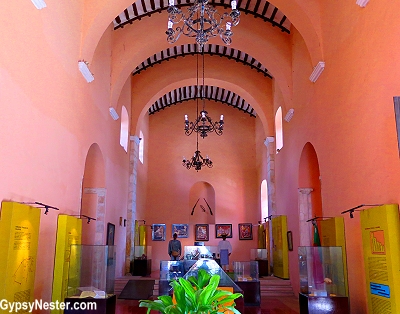
The building housing the museum is perhaps more interesting than the displays it contains.
Dating back to 1575, it was originally one of the five colonial churches in Valladolid.
A few decades later it was converted to a hospital, serving that purpose for nearly four hundred years before being converted into the city’s first electrical generation plant in 1947, then finally opening as the San Roque Museum in May of 1998.
A necessary plunge

The next leg of our ride, from the museum to Cenote Zaci, only took a few minutes but by the time we reached the ancient water source we were more than ready for a refreshing dip.

The tropical sun saw to that. Most of the cenote is hidden from the harsh solar rays beneath a cave covered with stalactites – making an inviting oasis in the midst of the city.

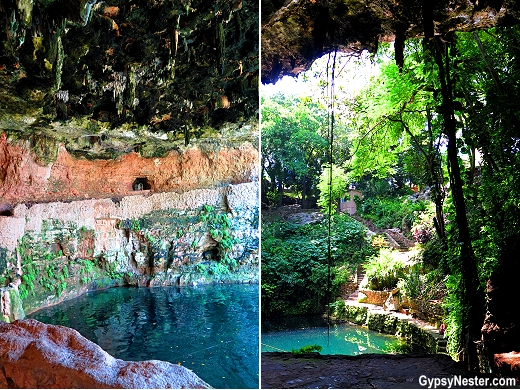

The fresh, cool water felt fantastic and, while not as colorful and bountiful as a reef, we were happy to have our snorkel gear with us for exploration purposes.
We didn’t make it anywhere near the two hundred and sixty foot bottom of the pool, but we did get underwater views of the cenote walls and the odd little eyeless black fish called lub.

Uh, yum!

Properly chilled and relaxed, our appetites kicked into high gear.
In Valladolid, as with everywhere we went in the Yucatan, street food was our midday sustenance of choice.
From giant banana leaf-wrapped tamales, to mouthwatering underground-pit-cooked pork conchinita pibil, we discovered dishes that trace their roots to the Mayan culture.
These — along with tacos, chicken, elote, frozen treats, and just about anything else our Mexican street food-lovin’ hearts desired — could be found at carts scattered all across the city.
But without a doubt the slow-cooked conchinita pibil was our favorite.
We found the tender delicacy everywhere — from street carts to fancy restaurants — so we ended up consuming our conchinita quota every day.
See more about the street food of Mexico!
WATCH: We eat our way through the Yucatan – calorie count not included, for your guilt-free viewing pleasure!
See more about the street food of Mexico!
Following the fathers’ footsteps

We resumed our ride on the other side of the square, taking the Calzada de los Frailes, or Avenue of the Friars, out to see the church and former monastery San Bernandino de Siena.
Franciscan monks built the complex in 1552, and it remains very much the same to this day.
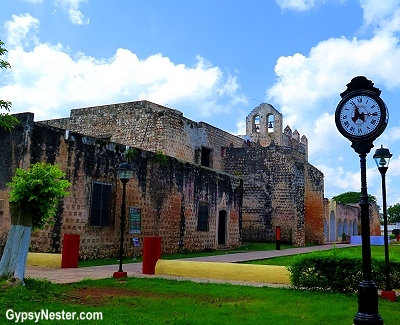
The avenue the priests used to go back and forth to town has been beautifully restored to its original colonial state and is considered one of the best preserved areas in all of Mexico.
Because of this it has become home to several attractions, two of which caught our eye.
Death by chocolate. What a way to go!
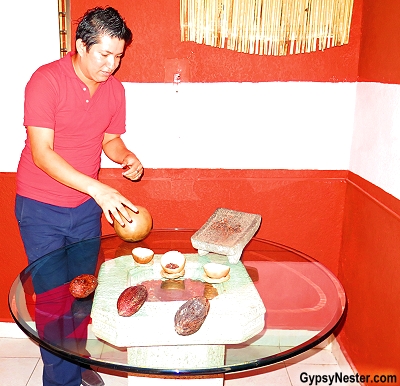
First we stepped inside the little storefront of the Cacao Chocolate Factory and discovered the story of chocolate as it related to the Mayan people.
Each of several small rooms demonstrated a different phase of the process as cacao is turned into chocolate.
Once they are removed from the fruit, the seeds are peeled and dried in the sun, ground up, mixed with honey and other flavorings, and hand formed into little balls.

By the end of the demonstration our mouths were watering. Fear not, the sampling room awaited and we tried all of the rich varieties, including chili, vanilla, orange peel, cinnamon, anise, tequila and xtabentun.
We should probably explain that last one.
Xtabentun is a traditional liquor of the Yucatan that when originally made by the Mayans consisted of fermented honey from the nectar of xtabentún flowers, a type of morning glory.

The name comes from the legend of Xtabay, who caused men to fall in love with her by using the same intoxicating effect as the drink, and when she died these beautiful flowers sprung up on her grave.
Now mere mortals are able to carry on the tradition.
When the Spanish arrived, they didn’t care much for Xtabentun, so they added anise for flavor and rum to kick things up a notch.

While we thought they had stumbled upon a pretty tasty combination – it sits on the tongue exactly like liquid Good ‘N Plenty – the Spaniards were still not overly fond of it.
Instead they began to focus their distilling prowess on the agave plant.
Ba-dadada-da. Tequila!
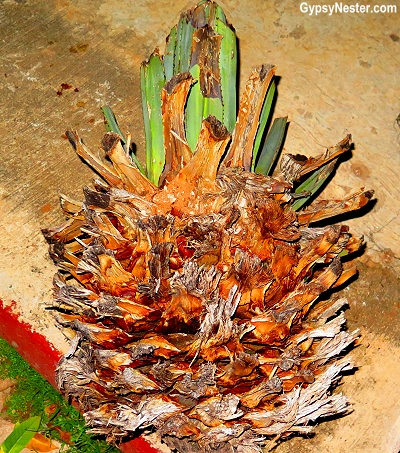
That turn of events brought us to our final stop; we snuck into the Tequila Tour Los Tres Toños just before they closed for the day.
While this is not where the actual tequila is made — Mexican law requires that the drink must come from the region surrounding the small town of Tequila in the state of Jalisco — the tour gave a brief, yet thorough, explanation of the process.
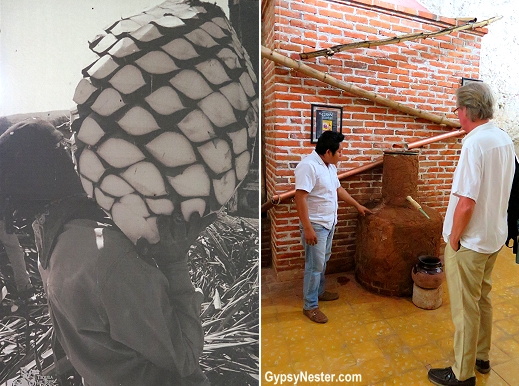

Once the juice of the blue agave is distilled into alcohol, the real magic that separates the varieties of tequila begins.
All tequila starts as blanco, or white; clear and typically un-aged, this is its purest form.
Some will then be put in barrels, where the aging process takes place. If rested less than a year the tequila becomes reposado, over a year añejo, or if the spirits are allowed to age for three years, extra añejo.

As we moved to the end of the tour, we were given the chance to taste these differences in the Tres Toños tasting room.
We are in no way experts on tequila, but after trying all of the above, we bought a bottle of ridiculously smooth añejo for David’s dad, who is an aficionado.
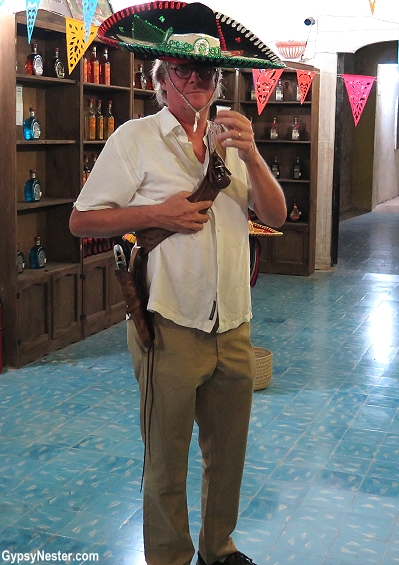
After that sale our host was more than happy to keep pouring samples, so we moved on to the flavored varieties.
While none of them knocked our socks off, we kept trying them anyway – just to be polite, we have manners after all – or perhaps for medicinal purposes.
Before long it felt like our socks were going to be knocked off in a different way.
Good thing it was our last stop of the day.
David & Veronica, GypsyNester.com
See all of our adventures in Mexico!
YOUR TURN: Is Valladolid your cup of tea-quila?



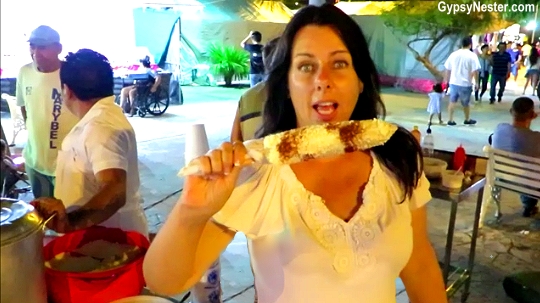



Where can one stay if one wished to spend several. Months?
Sorry, we don’t have any information on that.
I just ordered a pair of Bluffworks pants. Can’t wait to try them out in San Miguel!
Think you’ll like them. I love mine, so good for traveling. They take a beating and still look good.
We were just in Valladolid, Mexico last week after visiting the Ruins at Ek Balam. Stopped in the square across from the beautiful historic church. So nice to see your pictures and a more detailed look at this city.
Isn’t a great little city? We loved it.
Aah a Cacao Chocolate Factory!! Sounds like you really delved into the history and culture while your were there, great post!
Thanks Grace, we did!
Some nice pics, that dog looks like he wanted to jump in the water. Have heard a lot about that cenote, would love to see it!
Frank (bbqboy)
He watched the whole time and we thought the same thing, but he never did.
Wow you must have the best digestive tracts on the planet, or was it the Ensure,Active..
Both! 😉